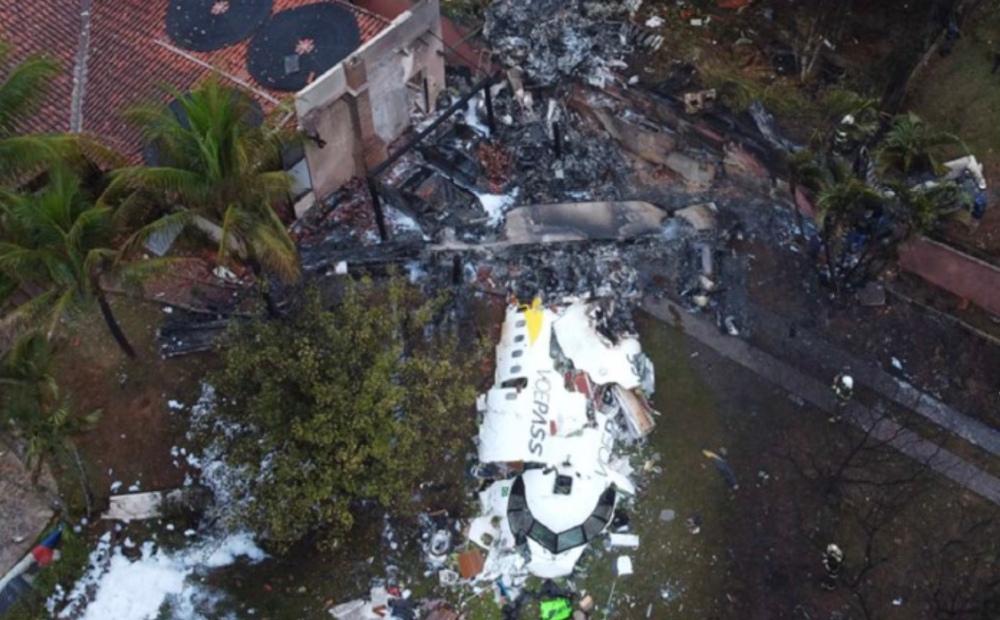Voepass Crash Probe Spotlights De-icing System, Flight Crew Procedures

Investigators probing the Aug. 9 fatal accident of a Voepass Linhas Aéreas ATR 72-500 are scrutinizing whether a de-icing system malfunctioned and how the flight crew reacted in response to the issue and increasingly dangerous icing conditions, a preliminary report suggests.
The crew of Voepass Flight 2283, en route from Cascavel Airport to Guarulhos International Airport in São Paulo, lost control of the aircraft shortly after beginning an assigned turn as part of its descent, the report from Brazil's CENIPA aviation accident agency released late Sept. 6 said.
The loss of control was preceded by three progressively more urgent low-speed alerts, the report shows. 10 seconds after the final alert, at 16:21:09 local time as the aircraft was turning at 169 kt., control was lost.
"The aircraft rolled to the left to a bank-angle of 52 degrees, and then rolled to the right to a bank-angle of 94 degrees, performing a 180-degree turn in a clockwise direction. Subsequently, the turn was reversed to an anticlockwise direction, with the aircraft completing five full rotations in a flat spin before crashing into the ground" the report said.
All 58 passengers and four crew onboard were killed.
The aircraft, carrying registration PS-VPB, was flying through weather conducive to severe icing conditions when control was lost, investigators determined. Among the ATR-prescribed procedures in such conditions is maintaining air speed equivalent to 30 kt above a predetermined "icing bug"--established by the pilots during pre-flight procedures based on aircraft's weight, the report said.
"During the execution of the procedures, the crew mentioned that the icing bug would be adjusted to the speed of 165 kt., a speed consistent with the calculations performed by the investigation committee," the report said.
In the 3 min. leading up to the loss of control, the pilots received a "cruise speed low" alert at 191 kt., a "degraded performance" alert at 184 kt, and an "increase speed" alert at 169 kt. Each is below the 195 kt. speed that a 165-kt icing bug calls for in severe icing conditions.
The alerts are triggered by the ATR 72's aircraft performance monitoring function, which uses aircraft and engine parameters to monitor aerodynamic drag under conditions of ice accretion and alerts the crew when necessary.
The pilots recognized they would encounter icing conditions. A propeller anti-icing system was activated at 15:12:40, about 14 min. after takeoff on the scheduled 2 hr, 10 min flight, followed shortly after by the aircraft's airframe de-icing system.
"Subsequently, the crew commented on the occurrence of an airframe de-icing fault, and that they would turn it off," the report said.
The system was deactivated and left off for just more than an hour. It was fully cycled again between 16:17:41 and 16:19:07. At 16:20:00, during what the first officer described as "a lot of icing," it was turned on for the final time--one minute before the loss of control.
The report mentions only one airframe de-icing system alert. It is not clear if the system was functioning as designed.
“What we have so far is that one of the crew members can be heard in the cockpit recording saying there was a failure in deicing equipment,” CENIPA lead investigator Paulo Fróes said at a briefing on the report's release. “But this has not yet been confirmed by the flight-data recorder.”
ATR's procedures for an airframe de-icing system failure call for leaving or avoiding icing conditions and turning the system off. Among the tasks in ATR's severe-icing protocol for the ATR 72-500 are an immediate descent and setting maximum continuous power.
The Voepass Flight 2283 crew flew its assigned route, cruising at about 17,000 ft (FL170), well within the forecasted severe-icing condition altitude range of FL120-FL210, the report showed.
At 16:19:19, just before being cleared to begin its descent, a Sao Paulo approach controller told Voepass Flight 2283 that it needed to maintain FL170 while traffic passed below.
One of the Voepass pilots acknowledged the controller, adding that the aircraft was "at the ideal point of descent, awaiting authorization," the report said.
The controller asked Voepass Flight 2283 to wait for clearance. One minute later, at 16:20:33, the aircraft was cleared to fly directly to SANPA.
The crew acknowledged the message and soon after, initiated the turn that preceded the loss of control.





